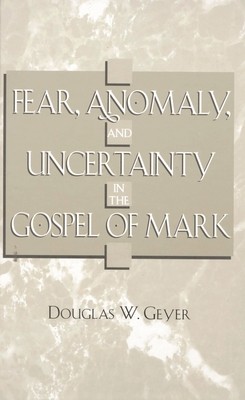
- We will send in 10–14 business days.
- Author: Douglas W Geyer
- Publisher: Scarecrow Press
- ISBN-10: 0810842025
- ISBN-13: 9780810842021
- Format: 15.5 x 22.5 x 2.4 cm, hardcover
- Language: English
- SAVE -10% with code: EXTRA
Fear, Anomaly, and Uncertainty in the Gospel of Mark (e-book) (used book) | bookbook.eu
Reviews
Description
Douglas Geyer's illuminating analysis of Mark 4:35-6:56 explains why the Gospel ends as it does in the earliest manuscripts-abruptly, at 16:8, with the words, "for they were afraid." This ending, with women fleeing the empty tomb in "trembling and astonishment," has long been considered "problematic," and, in the several attempts to rewrite it, Mark 16 has become a source of unending mischief. Geyer's work draws on a vast literature of fear, anomaly, terror, and dread in the ancient world to demonstrate that this ending is a consistent, overriding theme of Mark's Gospel. In Mark we see and hear the story of Jesus through the eyes and ears of the Roman world. Geyer brings to bear the literature of that world in a way that helps his readers to understand what Mark is doing and how the story that Mark tells continues to touch his readers and hearers ancient and modern (and "postmodern"). Geyer guides the reader through a vast and uncharted primary literature, demonstrating its relevance for New Testament study. In so doing he clearly proposes a fresh and original understanding of Mark that cuts across many of the critical controversies and renews its purpose and usefulness as "good news"-Gospel-for the terrors and uncertainties of our own time.
EXTRA 10 % discount with code: EXTRA
The promotion ends in 20d.02:31:12
The discount code is valid when purchasing from 10 €. Discounts do not stack.
- Author: Douglas W Geyer
- Publisher: Scarecrow Press
- ISBN-10: 0810842025
- ISBN-13: 9780810842021
- Format: 15.5 x 22.5 x 2.4 cm, hardcover
- Language: English English
Douglas Geyer's illuminating analysis of Mark 4:35-6:56 explains why the Gospel ends as it does in the earliest manuscripts-abruptly, at 16:8, with the words, "for they were afraid." This ending, with women fleeing the empty tomb in "trembling and astonishment," has long been considered "problematic," and, in the several attempts to rewrite it, Mark 16 has become a source of unending mischief. Geyer's work draws on a vast literature of fear, anomaly, terror, and dread in the ancient world to demonstrate that this ending is a consistent, overriding theme of Mark's Gospel. In Mark we see and hear the story of Jesus through the eyes and ears of the Roman world. Geyer brings to bear the literature of that world in a way that helps his readers to understand what Mark is doing and how the story that Mark tells continues to touch his readers and hearers ancient and modern (and "postmodern"). Geyer guides the reader through a vast and uncharted primary literature, demonstrating its relevance for New Testament study. In so doing he clearly proposes a fresh and original understanding of Mark that cuts across many of the critical controversies and renews its purpose and usefulness as "good news"-Gospel-for the terrors and uncertainties of our own time.


Reviews